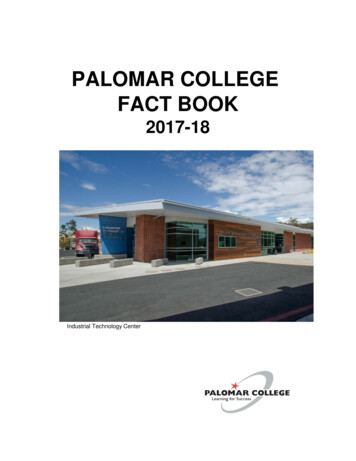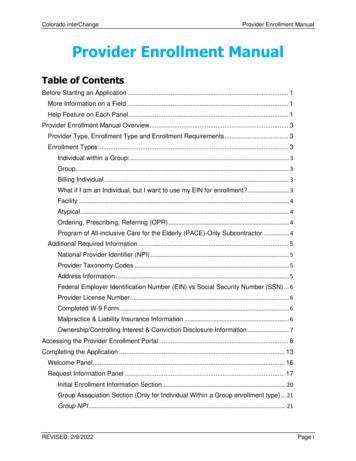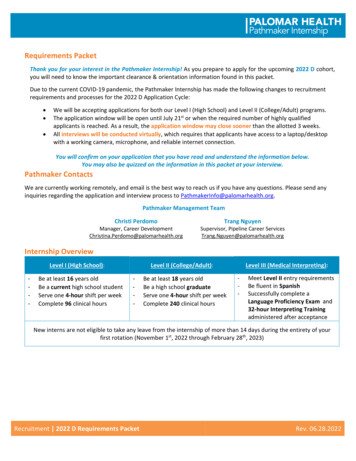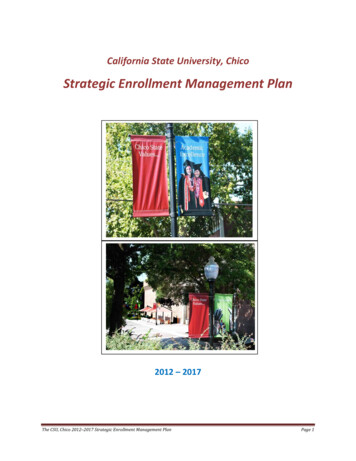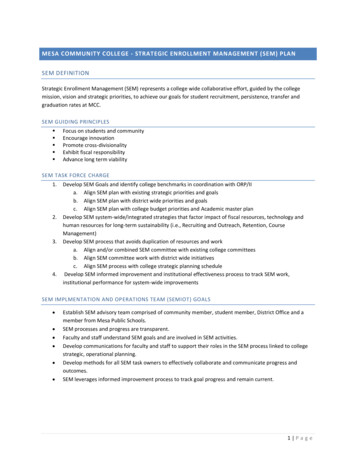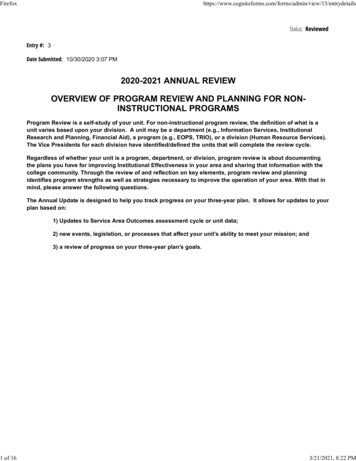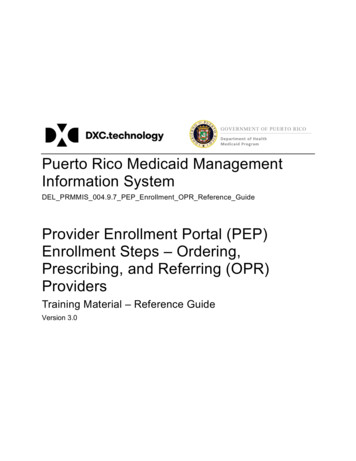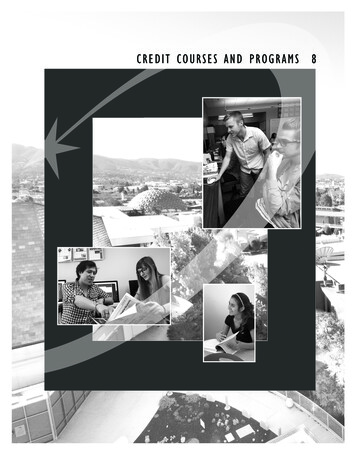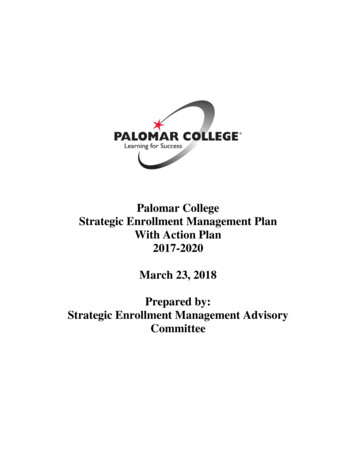
Transcription
Palomar CollegeStrategic Enrollment Management PlanWith Action Plan2017-2020March 23, 2018Prepared by:Strategic Enrollment Management AdvisoryCommittee
Table of ContentsPagePART I. SEM Background, Definition, and Roles at Palomar College . 1SEM Background. 1Palomar College and SEM. 2PART II: Palomar College SEM Plan 2017-2020 . 6Palomar SEM Plan Vision and Overview . 6Enrollment Management Planning Observations from the Data and PlanningAssumptions . 6Targeted Student Groups . 8Focus Areas, Strategies and Objectives. 8Overview . 8Focus Area: ACCESS. 9Focus Area: RETENTION AND COMPLETION . 10Focus Area: CONTINUED COMMUNITY INVOLVEMENT . 11Focus Area: IMPROVED INFRASTRUCTURE AND FISCAL STABILITY . 11Monitoring and Evaluating Plan Progress . 12Appendix A: Observations from the SEM Planning Data . A-0Appendix B: Strategic Enrollment Management Plan - Action Plan . B-012/05/17Page ii
Palomar CollegeStrategic Enrollment Management (SEM) PlanPART I. SEM Background, Definition, and Roles at Palomar CollegeSEM BackgroundThe concept of strategic enrollment management began at four-year universities to manage thestudent enrollment and success continuum, from inquiry through completion. From the late1970s through late 1980s the focus of SEM was primarily related to marketing and recruitment.During the early 1990s through the early 2000s the focus shifted to organization and focusingSEM efforts around a cluster of departments that are central to SEM, e.g., marketing,recruitment, retention, and completion.During the early 2000s, enrollment management began to shift and expand its focus. In 2004,Bontrager proposed a model that focused less on the strategies and interventions tied to theorganizational structure (e.g., recruitment and admissions), and more on the student milestonesand success. This broader framework considers the diverse student populations that communitycolleges serve, and their specific needs and goals. Moreover, this evolution of enrollmentmanagement incorporates strategic concepts of integrated planning, technology adoption, coursescheduling, registration, and data-informed decision-making.Bontrager’s holistic framework for SEM incorporates additional foci including orientation andfinancial aid, while also suggesting tangible strategies and practices to further advancemarketing, recruitment and matriculation that impact enrollment. In addition, Bontrager’sframework expands the SEM focus to include the student experience, suggesting that there aremultiple entry points where the college can influence enrollment. Within this structure studentclassroom experiences, instructional modalities, support services, co-curricular activities andcampus environment are factors that affect student success and retention.12/05/17Page 1
The introduction of Guided Pathways with its focus on establishing clear curricular pathways andthen providing support to help students identify, enter, persist, and complete their chosen pathwaysignificantly impacts SEM planning and implementation. In the Guided Pathways model, theintegration of student and instructional support services within a student's pathway is critical.Drawn from Achieving the Dream and Completion by Design, Guided Pathways may be defined asfollows."A Guided Pathway is a descriptive andeasy-to-use plan that guides a studentINTO and THROUGH college to thesuccessful COMPLETION of acredential and the transition to abaccalaureate program or the labormarket. A Guided Pathway integratesacademic and student services togetherin a coherent and intentional system ofcurricular and co-curricular experiencesthat match a student’s interests andgoals, and better prepare him or her forsuccess in a rapidly changing globalenvironment." (Insert reference)Palomar College and SEMThe SEM Advisory CommitteeIn Fall 2017, Palomar College established a Strategic Enrollment Management AdvisoryCommittee. This committee reports to the Strategic Planning Council the College's principalparticipatory governance group. The committee is constituent based and includes faculty,classified staff, administrators, and a student representative. SPC has charged the Committeewith developing a comprehensive SEM plan and then providing oversight for its implementation.The committee met throughout the fall term to develop the SEM plan. In its prior composition asthe SEM Task Force, the Committee established the following mission of enrollmentmanagement at Palomar College.Palomar seeks to design and monitor a strategic enrollment plan that includes both long andshort term strategies that meet the academic and relevant support needs of our diverse students,and that will serve to maintain Palomar College’s status as a viable, large and comprehensivecommunity college.12/05/17Page 2
Building from the mission, the Committee reviewed the purposes of SEM and examinedextensive internal and external data related to the community the college serves, student data,and program data. Using this information, the Committee established a SEM model for theCollege and then identified SEM goals and related strategies. The components of the SEMmodel, are Access, Retention, Completion, Community Engagement, and Fiscal Stability ( ) orARCC .Palomar College SEM Core Purpose StatementThe committee reviewed the IEPI SEM Applied Solution Kit's SEM Core PurposeStatement and agreed it fit well within the defined mission of enrollment management forPalomar College. Each member of the Committee felt they could see themselves andtheir role in SEM reflected in the core purpose statement. An adapted Core Purposestatement for Palomar College follows.As an open-entry institution, Palomar College serves a diverse student body with wideranging educational goals. We must regularly adapt our programs and services to meetthe changing needs of our students, and to facilitate the achievement of their educationalgoals. At the same time, we must maintain our fiscal viability to ensure that we cansupport our communities now and into the future.Strategic Enrollment Management (SEM) is a holistic concept and a process that enablesthe fulfillment of an institution’s mission and its students’ educational goals1. At PalomarSEM is a shared responsibility and student success is central to all related planningpractices and processes.In practice, the core purposes of SEM and SEM planning are to: Establish comprehensive student enrollment goals aligned with the college’s missionand strategic plan.Promote student success by improving access, engagement, persistence, andcompletion.Ensure fiscal stability and viability by optimizing enrollments and integrating SEMinto the college financial planning, budgeting, and allocation processes.Offer quality and relevant programs with clear educational pathways, courseofferings, and appropriate student support.Implement strategies that lead to equitable access and outcomes.Create a data-rich environment to inform decisions and evaluate strategies.Design and implement communications and marketing with internal and externalstakeholders to increase understanding of SEM and to meet SEM goals.12/05/17Page 3
Increase collaboration among departments across the campus to support theenrollment program.Roles of Constituent Groups in Enrollment ManagementThe following roles of Constituent Groups are reflected in Palomar's approach to SEM.Role of Established CouncilsEstablished Governance Councils discuss ideas that emanate from the SEM Advisory Committeeand also provide a structure to roll-out new SEM initiatives as they pertain to the specificcouncil. As shared governance entities, the councils also assist in the evaluation of whether thecurrent structure (and membership) of the SEM Advisory Committee will facilitate moving newinitiatives forward.Role of FacultyFaculty play multiple roles in SEM. First and foremost, as discipline experts, they create andrecommend curriculum, degrees, and certificates. They set standards, processes, and policiesregarding instruction, counseling services, and student success. They are experts on thepedagogical and student service needs of students as well as the career technical andoccupational needs of the community. As department chairs, they provide leadership, advocacy,and balance for both department needs and district goals. As members of the academic senate,they both work with their colleagues within the state and within the institution to ensurestatewide compliance with new initiatives, academic integrity and quality of instruction. Facultyserve on institutional committees and councils that inform SEM initiatives and provide importantinput on the overall goals of the institution.Faculty proactively work with staff and administrative colleagues to evaluate academicprograms. Utilizing data (internal, labor market etc.), faculty assist in evaluating programs andproactively create plans to address concerns. Faculty (instructional and student services) anddepartment chairs assist deans in program planning based on student needs, data, demand, andoverall needs of the program.Given the many roles faculty play to ensure student success, their voice, knowledge-base andactive participation is crucial to the success of any SEM plan.Role of AdministratorsAs a primary aspect of their role, SEM is an emphasis for college administrators. The way inwhich administrators carry out their SEM role is influenced by the division they represent (fiscal,student services, human resources, instruction), but engaging in strategic enrollmentmanagement is an assumption of a management role at a college.12/05/17Page 4
Administrators represent the birds-eye view of the college and use a data-informed approach toassist others to work toward plans that meet that broader view. They assist in criticallyevaluating all policies, processes, and procedures that affect enrollment and ensure these aremeeting the needs of the student. They also ensure those policies are being followed. Keepingstudent success as the primary driver of all SEM practices, administrators evaluate the progressof enrollment management initiatives with a student lens and focus on student success.Administrators work collaboratively and transparently with the faculty senate and otherconstituent groups. Administrators also pro-actively engage and include students, staff, andfaculty voices in all aspects of SEM. As the campus begins to shift to new operations,administrators are open to concerns from constituent groups, focusing on the overall goal andconcerns of stability and the need to improve strategies for success. Finally, using relevant data,administrators understand the balance of meeting the needs of instructional programs and studentservices, given the goals of maximizing apportionment, and being fiscally responsible to ourcommunity.Role of StaffStaff participate and are represented in strategic enrollment management discussions andprocesses. As front-line employees as well as representing the back-end workflow necessary forthe college to be successful, staff provide expertise, particularly on the enactment of processes asthey affect the student experience. Staff input is vital to a successful strategic enrollment plan.Staff evaluate customer service and all practices related to the student experience as a primaryelement of strategic enrollment management. Staff in student services are a key element in SEMas is relates to the student experience. Representatives of Financial Aid, Enrollment, Transfer,Assessment, etc. are engaged in analyzing practices that affect the student experience. Theyassist in creating mechanisms that eliminate and/or minimize roadblocks and help studentsachieve their academic goals. Akin to every vital constituent group, staff voices (whethercommenting on staff-specific roles or other elements) are included and respected in SEMdiscussions.Role of StudentsThe student perspective is critical to developing and implementing strategies for SEM. Studentsparticipate in Strategic Enrollment Management discussions and processes. Faculty, staff, andadministrators sometimes get "stuck" in their own perspective and use of language. The studentperspective reveals areas the college needs to address as well as provides for a reality check onidentified plans and strategies.Students work with the ASG and other student clubs to advocate and assist in meeting the needsof a diverse student body. To assist the campus in making data-informed decisions, studentsparticipate in quantitative and qualitative research that helps the campus in both creating newpractices and also in evaluating the efficacy of ongoing SEM practices. Finally, students expresstheir interests and concerns with instructional faculty, counselors, and staff. Student perspectives12/05/17Page 5
are crucial in moving SEM processes forward and their ideas and perspectives are included andrespected in all elements of SEM work.PART II: Palomar College SEM Plan 2017-2020Palomar SEM Plan Vision and OverviewIn Fall 2017, the Enrollment Management Task Force, now reformulated as the SEM Committee,identified the mission of enrollment management at Palomar as follows:Palomar seeks to design and monitor a strategic enrollment plan that includes both long andshort term strategies that meet the academic and relevant support needs of our diverse students,and that will serve to maintain Palomar College’s status as a viable, large and comprehensivecommunity college.When developing Palomar's Strategic Enrollment Management Plan, the Committee identifiedstrategic enrollment and completion goals to support the College's Integrated Planning Model andpurposefully aligned the plan with the College's Strategic and Master Plans.In establishing strategies to meet specified enrollment goals, the plan focuses on the entire studentlife cycle from connection, to access, to persistence, to completion. All areas of the college affectstudent enrollment and support student completion of their goals. Therefore, the plan iscomprehensive and includes strategies that touch every aspect of the college. As described earlier,once reviewing its role, the defining SEM purpose, and examining environmental data, the SEMCommittee established the ARCC model of SEM and then identifies strategies and objectives foreach focus area in the model.Enrollment Management Planning Observations from the Data and PlanningAssumptionsData HighlightsAppendix A contains a summary of the data the SEM Advisory Committee reviewed. TheCommittee examined and discussed the following information as part of the plan's development. General community observations (community demographics/high school enrollmentsand projections/Job Outlook) Budget, FTES, WSCH/FTEF, and enrollment trends over time(FTES/headcount/Efficiency) Student demographics and mix of course offerings Student outcomes (persistence and completion)Planning AssumptionsA comprehensive SEM model includes the development of planning assumptions. Building fromthe SEM Core Purpose statement and the Data Highlights, the following planning assumptions12/05/17Page 6
were established for the SEM planning at Palomar College.Overarching Planning Assumption regarding SEM and the environment The external environment in which the college operates will continue to change andinfluence enrollments. Infrastructures need to be in place to accommodate these changesin both the short-term and long-term. Enrollment funding cap determined by the state is subject to frequent change. The FTEStarget must be within a flexible range to increase or decrease based on information fromthe state regarding the budget. SEM must be responsive to changing economic and legislative conditions and thusprovide a framework for growth and reduction in programs. SEM acknowledges that some disciplines, programs, or degrees have unique needs thatmay necessitate flexible and unique planning, implementation, enrollment, studentsupport, and marketing strategies. SEM encourages fiscally responsible maintenance of current offerings, programs, andnew program development in order to attract, retain, and serve students. New program creation will take into consideration the emerging career opportunities ofthe region, and the necessity of a livable wage. Total resource impact will be consideredas part of program development and program planning.Planning Assumptions Guided by a Review of the Data SEM data highlights the impact high school enrollments/graduation, other postsecondaryoptions, and the economy has on enrollment stability. For example, over time, Palomarhas lost significant enrollments to its surrounding community colleges. A need exists for the college to develop and implement a model that integrates schedulingwith budgeting and ensures a workload that supports a balanced budget. Opportunity exists to implement and re-establish infrastructure to increase enrollments ofrecent high school graduates, noncredit student, and career and technical educationstudents. Opportunity exists to implement strategies that increase the number of continuingstudents (e.g., persistence/retention/progress). Student progress and completion is acritical element of the SEM plan. Opportunity exists to improve/increase partnerships with local business and industry. Opportunity exists to integrate SEM enrollment goals and strategies across the college(e.g., marketing and outreach should focus on meeting FTES targets. enrollment goals forspecific student groups, and new locations). Opportunity exists for the college to improve its infrastructure and services to makecollege coursework the most difficult thing about attending Palomar. Schedule development must link to and be supported by the SEM plan. A Budget Allocation to FTES Target model must be established and utilized to achievethe FTES target Cap (including growth, when available) in order to meet student needsand ensure the college remains fiscally viable.12/05/17Page 7
Targeted Student GroupsOne defining element of a SEM plan is the focus it places on establishing enrollment goals forspecific student groups. As Palomar's enrollment is in decline, the SEM Advisory Committeerecognizes the need to optimize enrollment across all student groups. The plan places specialattention to establishing an infrastructure and increasing student enrollment in the followingstudent groups/programs.Student GroupCurrent High School StudentsNew Students (Direct Matriculants)Online Student EnrollmentContinuing studentsOlder Adult and CTETargetIncrease concurrent/dual enrolled studentenrollment by 100%Increase high school capture rates from 21% to33%.Increase online student enrollment by 15%Eliminate trend of decreasing numbers ofcontinuing students.Reestablish noncredit, career technology, andcontract education programsFocus Areas, Strategies and ObjectivesOverviewTo achieve the targets for the student groups listed above, promote student success andoutcomes, and ensure the College maintains its fiscal viability; the SEM Advisory Committeeidentified a set of strategies and corresponding objectives for each element in the SEM ARCC model. Then, the Committee identified high, medium, and low priority/sequencing objectives toaccomplish each strategy. The criteria utilized for sorting objectives into priority categoriesincluded, but was not limited to, the need to establish infrastructure to better manage enrollment and student success, potential impact on FTES, need to stabilize enrollment, sequencing (what work needs to come first), and time needed to develop and implement.The SEM plan is aligned with the College's current Strategic Plan 2019. This alignment isshown by including the Strategic Plan's goal and corresponding objective in parenthesis byrelevant strategies and objectives in the SEM plan.For example, Strategy 1: Increase access through new locations, partnerships, and programs(5.1, 5.2) under the SEM Plan's ACCESS Focus Area is aligned with Strategic Plan 2019's Goal5 Objectives 1 and 2 which state: Goal 5: Ensure the fiscal stability of the college and increase enrollments.12/05/17Page 8
o Objective (5.1): Increase course offerings in the southern portion of thedistrict while maximizing enrollment on the main campus.o Objective (5.2): Increase course offering in the northern portion of thedistrict while maximizing enrollment on the main campus.For each strategy and objective in the plan, the College will create a corresponding action planidentifying individuals responsible, project tasks and timelines, and specific outcomes. Inaddition, a SEM Scorecard will be established and organized by Focus Area to allow the Collegeto monitor progress on the plan.Focus Area: ACCESSStrategy 1: Increase access through new locations, partnerships, and programs. (5.1, 5.2)High priority objectives (build infrastructure, potential significant impact on FTES, stabilizeenrollments across the district) A1.1. Open North and South Education Center. A1.2. Expand Concurrent/Dual Enrollment programs. A1.3. Expand Distance Education programs and offerings where appropriate. A1.4. Partner with local business and industry to reestablish contract education, non-credit,and continuing education programs.Medium priority objective (build infrastructure, impact revenue) A1.5. Increase international education partnerships.Strategy 2: Develop and implement integrated, targeted, and comprehensive outreach,marketing, and communications plans aligned with instructional programs, offerings, andcalendars. (3.1)High priority objective (must have in place to effectively support Strategy 1 above). A2.1. Develop and implement integrated marketing, outreach, and communications plansfor each of the targeted student groups and new locations identified in Focus AreaACCESS Strategy 1.Medium priority objective (build infrastructure, would support outreach and marketing,represents a technology tool to help staff accomplish this work, objective 2.1 has to come firstthough). A2.2. Develop and implement technology tools such as a CRM to help facilitatecommunication and follow-up with students expressing an interest in attending Palomar.Strategy 3: Simplify enrollment and registration processes. (Make college coursework thetoughest part of going to Palomar College)12/05/17Page 9
High priority objectives (builds infrastructure, impacts ALL students, highly rated across theCommittee, including our student representative.) A3.1. Develop and implement technology-based solutions to simplify student application,registration, and enrollment for classes. A.3.2. Examine and modify registration processes and timelines to better accommodatestudent need (e.g., move fall registration into spring; one-year enrollment process). A.3.3. Streamline and improve financial aid services to ensure students receive timelyaccess and support.Focus Area: RETENTION AND COMPLETIONStrategy 1: Implement Guided Pathways.High priority objective (potentially transformational, will take time so need to start now, fundingavailable, intentionally integrates college across instruction and student services). RC1.1. Implement Guided Pathways in a manner that is aligned with associated elementsidentified in the state's model. (2.2, 2.3)Ensure the following is addressed as a comprehensive approachStudent Service Support and Follow-up Implement approaches to more effectively communicate and implement follow-upwith students. Develop and implement comprehensive retention plan that includes targeted followup and support and facilitates a sense of belonging on campus. Implement technology solutions to assist faculty, staff, and students in educationplanning and tracking of progress towards goals (degree audit, electronic educationplans, and early alert) Ensure students receive accurate and timely counseling services support Implement programs such as second year experience/adult promise with integratedstudent support.Curriculum and Scheduling Clearly mapped programs / MetaMajors Assessment and evaluation of schedule to ensure it meets needs of students Innovative program development supported Alternative schedulingProfessional Development and Support for Faculty, Instruction, and Student ServicesStrategy 2: Develop and implement strategies that facilitate student completion and decreasetime to completion. (2.3)Low priority objectives (not sure of the FTES impact after looking at data, math is currentlyworking on projects to accelerate completion of math sequences and AB 705)12/05/17Page 10
RC2.1. Implement "Just One More" campaign to encourage part-time students totransition to full-time students.RC2.2. Implement accelerated programs to support completion of math sequences.Focus Area: CONTINUED COMMUNITY INVOLVEMENTStrategy 1: Strengthen Palomar's presence in the community.Medium to low priority objective (Outreach plans should address some of what would beaddressed in this objective; college is making a concerted effort to strengthen presence currently,once outreach plans are created this objective could be evaluated and worked on) CC1.1. Develop short-term and long-term community engagement activities to reintroducethe community to Palomar's updated campus and centers.Focus Area: IMPROVED INFRASTRUCTURE AND FISCAL STABILITYStrategy 1: Improve operations and budgeting to ensure continued fiscal stability. (5.4)High priority objectives (fiscal viability is critical and needs to be addressed, diversity of facultyand staff highly rated across the committee and the importance of improving the hiring processto improve opportunities to hire the best faculty and staff need to happen) .1.1. Develop and implement a financial recovery plan to ensure a balanced budget. 1.2. Implement improvements to recruitment and hiring processes (includingtechnology) to increase efficiency of hiring and provide support for the enrollment plan'sgoals.Strategy 2: Implement models that integrate enrollment forecasting, scheduling, and budget.(5.5)High priority objectives (related to fiscal viability of the college, Institutional EffectivenessRecommendation from accreditation) 2.2. Implement model that connects budgeting to scheduling and results in improvedFTES/FTEF. 2.2. Evaluate facilities utilization across the district to ensure efficient and effective useof classrooms.Strategy 3: Implement approaches that facilitate the use of data to make informed decisions.High priority objectives (needed to track progress on SEM plan, needed (student engagement andsurvey) as part of accreditation standards)12/05/17Page 11
3.1. Conduct Community College Survey of Student Engagement as part of the ongoingenvironmental scan of the college's community. 3.2 Develop report (scorecard) to track progress on enrollments/persistence/completionin a simple to use format.Strategy 4: Develop and align facilities to meet the needs of students and our community.Medium priority objectives (these are ongoing and good to keep; facilities plays role in SEM andshould be represented as well) 4.1. Ensure new facilities provide for student needs. 4.2. Implement universal design principles in facilities projects.Monitoring and Evaluating Plan ProgressTo track and monitor progress on the SEM plan, the College will create a SEM Scorecard. TheScored will be organized by Focus Area and each metric aligned with at least one strategy. Theacademic year, 2016-17 will serve as the baseline year. The Scorecard will include, but not belimited to the following metrics:ACCESS Number of applications/enrollment ratio Participation rate by ZIP Code High School Capture rate Enrollment by student status (e.g., special admit (K-12), new student, new transfer,continuing, returning) Enrollment by Credit/NonCredit status Enrollment by full-/part-time status Student Voice: Community College Survey of Student Engagement / Focus Group onApplication and Registration processesRETENTION AND COMPLETION California Community College Scorecard Metrics (utilize both leading indicators andfinal outcomes metrics to establish momentum points and outcomes - includespersistence, 30 unit completion rates, basic skills completion rates, andcompletion/transfer rates) Median time to completion Degree, certificate, and transfer volume Curriculum mixCONTINUED COMMUNITY INVOLVEMENT Number of new partnerships established each yearFISCAL STABILITY( )12/05/17Page 12
FTES to enrollment capRe
baccalaureate program or the labor market. A Guided Pathway integrates academic and student services together in a coherent and intentional system of curricular and co-curricular experiences that match a student's interests and goals, and better prepare him or her for success in a rapidly changing global environment." (Insert reference)
